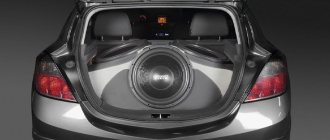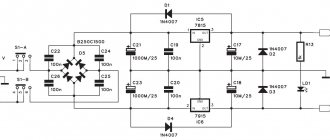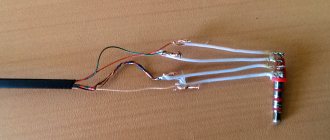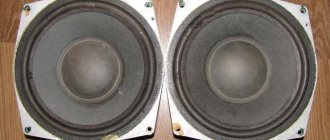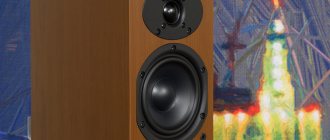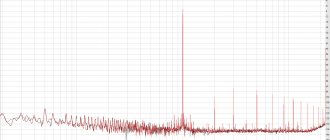Amphion Argon 3S bookshelf monitors
Many music lovers would like to listen to their favorite recordings exactly as they sounded in the control room during recording and mixing. But professional acoustics are usually too expensive and are not always suitable for home interiors. Finnish engineers offer a way out.
The monitors we are going to listen to have an interesting background. In 2015, the Amphion company, which has a very strong professional division (more about that here), released One 18 two-way near-field monitors. They turned out to be so successful that rave reviews appeared not only in specialized magazines for professionals, but also in mass hi-fi magazines. . After this, Anssi Hyvönen, the founder and chief developer of the company, decides to release a version of these monitors for home use with a more affordable price.
Unlike a bass reflex, a passive radiator does not delay the attack and does not produce turbulent overtones.
The dimensions, number and caliber of drivers, and hence most of the parameters of the Argon 3S are the same as those of the One 18. And the main solution that our test subjects adopted from professional models is the “passive radiator” acoustic design. Let me remind you what it is. A speaker is installed in the speaker housing without a voice coil of a magnetic system, whose own resonance determines the lower limit of reproduction. This solution allows you to get a lower reproduction limit than in a closed box, but, unlike a bass reflex, a passive radiator does not delay the attack and does not produce turbulent overtones. Why, given such advantages, is it rarely used in home acoustics? Yes, it’s just that a speaker, albeit in a disassembled form, is much more expensive than a plastic or aluminum tube.
In Argon 3S, the lower register is handled by a 6.5-inch SEAS driver with an aluminum diffuser. This diaphragm is characterized by high rigidity and low weight, but has one unpleasant property - a tendency to resonance in the region of 3 kHz. In our case, they are not audible, because Anssi chose a very low crossover frequency of 1600 Hz. In addition, the inevitable phase shifts at the junction of the bands are outside the zone of maximum sensitivity of our hearing (2000 - 4000 Hz). The most difficult thing in this situation was to find a tweeter capable of picking up the baton from the midbass at such a low level. I had to borrow an expensive SEAS Integrator emitter with an inch titanium dome from the flagship Krypton3 model. As you can see in the photo, it is fairly recessed into the body, and this is done so that the voice coils of both heads are at an equal distance from the listener’s ears. Due to this, high radiation coherence is achieved, i.e. time synchronization of signals with different frequencies. In addition, the tweeter is placed in the center of a wide funnel - this is the proprietary Amphion UDD (Uniformly Directive Diffusion) principle, which provides a linear frequency response not only on the acoustic axis, but also when deviating from it. In other words, if you fail to place your monitors symmetrically relative to your listening position, the tonal balance will not be affected. The same waveguide is used in the One 18 monitors, with the only difference that in them it is machined from Corian (artificial stone), and in Argon3S it is machined from high-density MDF. The internal wiring is made of silver-plated copper wire.
The passive head is installed on the rear wall. The caliber is the same as the main driver, and the diffuser is also aluminum, but without the phase-equalizing “bullet” in the center.
I had to borrow an expensive SEAS Integrator emitter with an inch titanium dome from the flagship Krypton3 model.
Another element borrowed from the professional line is the Argento Audio input terminals with large plastic cups instead of the usual gold-plated posts with a union nut. You can quickly connect bananas, spatulas, and stripped wires to them without touching the bare contacts and without the risk of shorting anything. Very comfortably.
Monitors are manufactured in Finland. The cases are rigid, the finish (in our case, natural walnut veneer) is impeccable. Such monitors will not look like a foreign body even in the richest interior.
There is a complete feeling that acoustics are playing with at least an 8-inch low-frequency driver: the bass is powerful, with a sensitive impact, dense and fast.
Since the amplifier with which we listened to the monitors, Lyngdorf TDAI-2170, is completely digital, we connected to the source first via HDMI, and then, for comparison, via coaxial. To be honest, without much hope of hearing a difference, but more on the results of this experiment below.
Regardless of the connection method, the Argons demonstrated an amazing combination of qualities. Firstly, the bass. The lower declared limit of the operating range is 30 Hz, but you can’t always trust what is written. In our case, there is a complete feeling that acoustics are playing with at least an 8-inch low-frequency driver: the bass is powerful, with a sensitive impact, dense and moving. Fast series of snare drums are transmitted without puffing, with a sharp front and perfectly measured intervals. The general character of the presentation is free, open, and at the same time the sound picture itself is drawn with very subtle strokes.
But the main feature of the monitors, like any Amphion acoustics, is the construction of a three-dimensional space with absolutely physical images. Something similar to a 3D video projection is created, everything that happens in the sound stage is so easily visualized. By the way, the differences when connecting via HDMI and Coax are felt primarily in the so-called. separation. With coaxial, a more noticeable perspective in depth is obtained and the spectrum is slightly expanded in the upper part of the range. So the Argon 3S are not only musical, but also incredibly accurate, and can be used as a tool to evaluate the sound of other components. And most importantly, with all their monitoring, they do not allow the listener to get bored thanks to their extremely lively character.
Something similar to a 3D video projection is created, everything that happens in front of the listener is so easily visualized.
Amphion Amphion Argon 3S
Manufacturer: Amphion Loudspeakers Ltd. (Finland)
www.amphion.fi
Configuration: 2 emitters, 2 bands || Acoustic design: passive radiator || Frequency range: 30 - 25000 Hz || Sensitivity: 87 dB || Nominal Resistance: 8 Ohms || Crossover frequency: 1600 Hz || Recommended amplifier power: 10 – 150 W || Finish: standard white, full white and black, natural walnut veneer. Grills - 9 standard colors and upon request - any from the RAL list || Dimensions: 191 x 380 x 305 mm || Weight: 12 kg || Price per pair: 225,000 rub.
SYSTEM
- DVD player OPPO BDP-105D
- Integrated amplifier Lyngdorf TDAI-2170
- Cables: interconnects and speakers: Wire World Oasis
- HDMI Wire World Ultraviolet 7 0.3 m
- coaxial Wire World Chroma 7
MUSIC
- “Tutti! Orchestral Sampler". 24 bit HDCD Reference Recordings, 1997
- Squirrel Nut Zippers, "Bedlam Ballroom". Mammoth Records, 2000
- Deep Purple, "Made in Japan". EMI, 1972
- The Rolling Stones, "Let It Bleed". ABKCO Music and Records, 1986.
- "Great Cover Versions". Inakustik, Reference Sound Mastering, 2013
share
Tags: AmphionArgon 3SLyngdorfOPPOWire WorldExpert's Choice
Amphion Argon 3
It didn’t really happen! I slowly approach work. I enter and right from the entrance I look around the salon in search of something new and unknown for me. Despite the fact that not much time has passed since my last visit to the store, the assortment has been significantly replenished, which sincerely pleased me. The first thing that caught my ear was the Amphion Argon 3L speaker systems connected in the main hall; from the first notes I realized that the sound was quite pleasant. Deciding not to disassemble the system assembled by my colleagues, I took the currently free Amphion Argon 3 bookshelf speaker systems with me into the listening room, leaving the floor-standing Argon 3L to delight the ears of other occupants of the salon.
I admit honestly, if the older brothers of Amphion Argon 3 had not been playing at the time of my appearance in the salon, then I would not have decided to listen soon, because the specificity of the strict Scandinavian design leaves no chance of catching my eye on them. Simple, rectangular, with sharp corners, the Amphion Argon 3 sits in front of me, ready to be listened to. At first glance, the minimalist, and perhaps even a little rustic design does not promise anything interesting; it seems that if the appearance was not given due attention, then the sound quality could be ignored, but, as it turned out, this is not at all the case.
At first glance, the design of the speaker systems seems quite simple and familiar. In essence, Amphion Argon 3 are classic two-way speaker systems. Two-cable (Bi-wiring) connection is not provided, as evidenced by only one pair of terminals. But, despite the outward commonality, Argon 3 also has distinctive features, which include the light “horn” design of the metal high-frequency emitter, as well as the absence of the usual removable grill, instead of which a non-removable metal protective mesh is installed. It was also unusual to find a very modest-sized bass reflex on the rear panel. Its very presence did not cause surprise, but the diameter was relatively small, which indicates that its resonant frequency was not too low. Perhaps that's enough discussing appearances, let's start listening.
The very first sounds dispel all doubts, the acoustics are wonderful! It was unexpected for me that a modest-looking acoustic system could amaze me with its sound. It was at this moment, when I began the fascinating process of understanding the rich inner world of Amphion Argon 3, that the thought came to my mind that these acoustics were created for those who live by music, those who have already “outgrown” brand wars and left the race for pathos and the title of the happy owner of an expensive system from a well-known manufacturer. Amphion Argon 3 will be appreciated by those who judge high-quality equipment not by the number of stars in a famous thematic magazine or by appearance, and certainly not by dry technical parameters, but by sound and the ability to reveal the soul of a piece of music, forcing the listener to spend long hours of pleasant listening in the company of the system. Despite my admiration for the sound of the Amphion Argon 3, I still understand that the epithets: wonderful, magical, magnificent, do not allow us to form a holistic understanding of the nature of the sound of the speakers, so let's approach listening objectively. The tonal balance is not bad at all, nothing “sticks out”, there are no obvious dips either, but, nevertheless, I am inclined to say that the Amphion Argon 3 relies mainly on the sound of the mids and highs.
The reason for this is not restrictions on the size of the columns; I am inclined to believe that this was the original position of the company's developers. These thoughts were prompted by a modest-sized bass reflex, which initially assumes the impossibility of extracting thunderous bass. For the first time I thought that maybe the low frequencies don't always have to be the basis of everything, at least if it was their slightly more modest sound that allowed the overall sound quality to rise to such heights, then I'm willing to give up the lows. Don't get me wrong, I didn't experience a lack of low-frequency presence, but I generally expected more bass presence based on my experience listening to similar-sized speakers from other manufacturers. The sound of Argon 3 is not overloaded, but at the same time surprisingly full-bodied and complete, there is not the slightest feeling that anything is missing. The confident sound of the double bass and bass guitar does not allow any doubts to lurk about the modesty of the lower parts. Only heavy rock music with an abundance of guitar riffs lost a little in confidence and power; I missed the explosive wave in the chorus of “Steel Loving You” of the legendary “Scorpions”. Pop music with electronic bass and club music, although teetering on the edge of a little lightness, still confidently retained their positions. Amphion Argon 3 is a surprisingly fast acoustic, low frequencies are very prominent and textured, there is not the slightest blurring.
So we got to the mids and highs. They were the ones that impressed me the most with their realism. Stunning accuracy and detail of the sound of mid and high frequencies, combined with an extraordinary, incomparable airiness, contributes to the formation of a mesmerizing stereo picture. The sound images created by Amphion Argon 3 float in the air, extending far beyond the boundaries of the listening room. The speakers do not hold the sound, but part with it with extraordinary ease, involuntarily making you doubt your involvement in everything that is happening, it seems that the melody is born out of nowhere. Excellent transfer of space, sound images appear before the listener in full size, and not in reduced copies with lost grandeur. The vocal parts deserve special admiration; I have not heard such realism for a long time. The intonation and timbre of each performer’s voice is conveyed in the smallest detail, which undoubtedly allows not only to evaluate the performer’s talent, but also to feel his mood and emotions that he experiences at the moment of performance.
Airiness, musicality, detail, realism, space... I don’t have enough words to describe all the advantages of the sound of Amphion Argon 3. This is exactly the case when technology “steps over” a certain border and becomes an art. Amphion Argon 3 is not just a speaker system, it is a musical instrument, the purest window into the world of music, created by the greatest masters of their craft.
Author: Maxim Shmelkov
Amphion acoustics: a fresh look at old problems
Do you want to listen to music quietly, but still evoke strong emotions? Are you looking for acoustics that do not require special room treatment and that sound great in any interior? Do you strive for naturalness in sound, but are not ready to pay many millions for it? Do you think we are joking and all this is impossible, at least for not the richest people? No, we are absolutely serious. Amphion founder Anssi Hyvönen is confident that this is possible.
Selecting acoustics is the most difficult stage in building a system. Not only is it at the stage of electro-mechanical transformation that the strongest distortions are introduced into the sound, the situation is further aggravated by the fact that the sound of the speakers is determined not only by themselves, but also by the acoustics of the room in which they are installed. So it turns out that when purchasing speakers, we play the lottery, trying to win a lucky ticket - a model that will give the very sound we dream of in a particular room. How big are the chances of winning?
Quite large if the goal when developing acoustics was to reduce the influence of external resonances on the sound. It is unlikely that it will be possible to eliminate it 100%, but it is quite possible to significantly reduce it. Amphion achieved this using U/D/D (Uniformly Directive Diffusion) technology.
It must be said that many developers have long understood the importance of variance. Many experiments have been carried out showing that a wide polar pattern is one of the most important indicators affecting the subjective perception of sound. But the founder of Amphion went further, establishing: what is important is not wide, but uniform and controlled dispersion, not only in space, but also in time.
In practice, this is achieved through a precisely calculated arrangement of drivers in the housing and a special waveguide at the tweeter, designed in such a way as to ensure optimal phase matching with the mid-frequency emitter, as well as to obtain a strictly defined directivity characteristic. And not only.
Element No. 36
The flagship Krypton3 floorstanding speakers (its first generation was released 15 years ago) stand alone in the Amphion catalog. In addition to the fact that this is the only 3-way model of the company, it does not apply to one of the fundamental principles of the company - to achieve the required quality within the framework of a reasonable price according to European standards. These are High End acoustics with a corresponding price tag, a certain standard of quality in the mind of Anssi Hyvönen.
In addition to U/D/D technology, it uses 8-inch midrange drivers with specially designed paper diffusers. Thanks to the con, they operate in the critical range of 600 - 2000 Hz as a 4” caliber emitter, which increases resolution, improves transient characteristics, and adds “air”. And all this while maintaining a low level of distortion and high overload capacity of 8-inch drivers. These heads operate from 160 Hz, which allows you to limit the operating frequency range of the 10-inch low-frequency driver (it is located on the side panel) and thereby reduce distortion at low frequencies.
Regarding dispersion, the midrange of these speakers has a cardioid-shaped directivity characteristic, which reduces the influence of room acoustics on the sound. The level of lateral reflections of Krypton3 is 20 dB lower than that of conventional speakers, which allows you to install these acoustics in small rooms, next to large windows and simply in “difficult” rooms. It is largely thanks to this feature that Krypton3 has earned enthusiastic responses from many reputable experts. After all, let’s be honest, most of them conduct tests in ordinary residential premises without acoustic treatment.
The class of this acoustics is eloquently demonstrated by the fact that with dimensions of only 1370 x 240 x 470, each Krypton3 speaker weighs 72 kg. As we can see, the company does not rely on managed variance alone; it applies all the classical approaches. It’s easy to guess why this model got its name: its body is absolutely inert, like the gas krypton (occupies 36th position in the periodic table). However, almost all other Amphion home speaker lines are named after inert gases.
Element No. 18
If we take into account the exclusive status of Krypton3, then Amphion’s senior line is Argon (the third element in terms of content in the earth’s atmosphere after oxygen and nitrogen). Accordingly, the line is the most extensive. It has two floor-standing models (7L with two mid-bass drivers and 3L with one), three bookshelf (0, 1, 3) and one center (5C), identical in drivers and crossover to the floor-standing 7L, but in a shortened horizontal case .
The main difference of this line is the midrange-woofer speakers with aluminum diffusers, and therefore a slightly different sound “handwriting”, which can be characterized by the definitions of accuracy, neutrality and musicality. These qualities are extremely rarely combined in one acoustic system - more often one or the other is found. But Amphion managed to “marry” them.
The most interesting, in my opinion, is the older model of the 7L series. A pair of 6.5" woofers allow it to reproduce low frequencies from 28 Hz (+/- 3 dB). The weight of one column is 30 kg, dimensions 1160 x 191 x 305 mm. But the most interesting thing is the sensitivity of 93 dB (the highest of all the company’s models). If we remember the characteristic ability of Amphion acoustics to open up at low volume levels, you can safely use Argon 7L with low-power amplifiers - operating in class A or tube ones.
Element No. 2
A little lower in the Amphion hierarchy is the Helium line (helium is second in the table). It includes one floor-standing model (Helium 520), two bookshelf models (Helium 510 and 410), a central channel (520c), which is identical to the floor-standing models in terms of drivers and crossover, but in a smaller and horizontal case. The built-in Helium 600 drivers are arranged according to the d'Appolito principle, like the models 520, 510 and 520c, but the midrange-woofers are of a smaller caliber (4.5”) - like the 410 bookshelf speakers. Speakers with a 5 in the index have drivers with a diameter 5.25”, and their frequency range starts from 40 Hz (520, 520s) or 47 Hz (510).
The U/D/D technology in this series also provides a cardioid pattern and little influence of room acoustics on the sound. The diffusers of the mid-bass drivers in all models of the line are made of paper, and their relatively small diameters make it possible to do without such a complex profile as in the speakers of the older series. The tweeters are titanium, however, like all Amphion models. Absolutely all experts familiar with this acoustics note a warm and at the same time accurate, natural sound. And no harshness or tint, which is often blamed on tweeters with metal domes.
Oddly enough, the most compact and inexpensive model of the Helium 410 series causes the greatest delight among the serious audio press. Probably because the speaker with dimensions of 259 x 132 x 220 gives an unexpectedly full-bodied, dense sound and can easily do without a subwoofer. Like all Amphion speakers, it is available with grilles in a variety of RAL colors, allowing you to liven up any modern interior.
World of numbers
The most striking thing in the history of the young Finnish company (it was created in 1998) is its rapid recognition in the very conservative and unhurried professional recording environment. Among the sound directors, engineers and producers who have chosen Amphion to work in their studios are many winners of prestigious music awards: Bruce Swedien (recorded Quincy Jones, Count Basie, Art Blakey, Duke Ellington, Dizzy Gillespie, Oscar Peterson, Herbie Hancock, Roberta Flack, Mick Jagger, Paul McCartney, Barbra Streisand, Donna Summer, Sarah Vaughn and others, awarded five Grammys), Jesper Kyd (BAFTA award winner, author of music for films and popular games, in particular, Assassin's Creed, Hitman, Unreal Tournament 3 and etc.), Dave Reitzas (recorded and mixed discs of Madonna, Celine Dion, Michael Bolton, soundtracks for the films “Bodyguard”, “Evita”, etc.) and many other sound professionals.
There are only two studio acoustic lines: One (three models, all with one mid-bass driver) and Two (two models with a pair of mid-bass speakers). The fundamental difference from home lines is the use of passive radiators instead of conventional bass reflex ports, and their number is equal to the number of low-frequency speakers. All models are bookshelf, which is why the company produces the BaseOne25 subwoofer and the BaseAmp500 amplifier for it.
Since all studio models are passive, they need amplifiers, and Amphion makes them too: the Amp100 Mono, the Amp100 and Amp500 stereo. It even has its own speaker cable - twisted with silver-plated copper conductors.
Hopefully we'll have the opportunity to experience Amphion products first hand. So follow our publications.
share
Tags: Amphion
